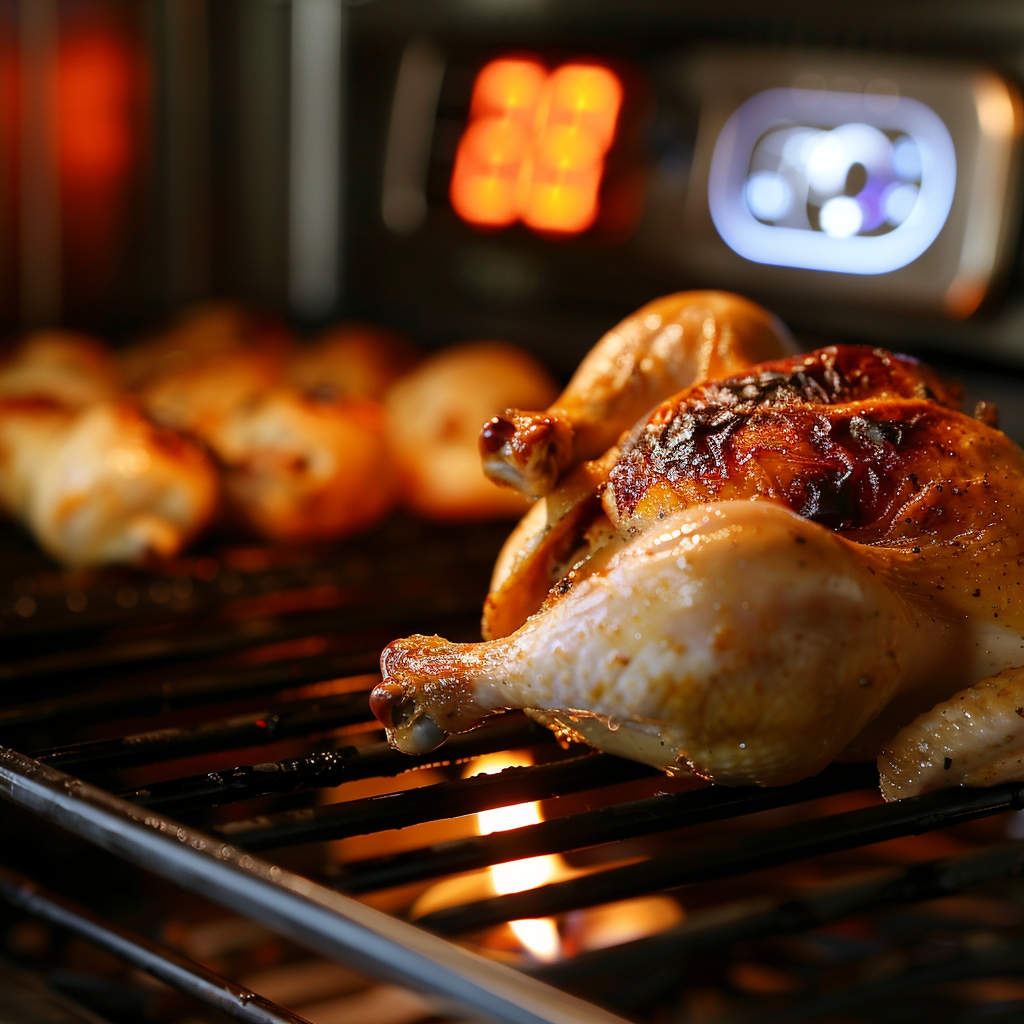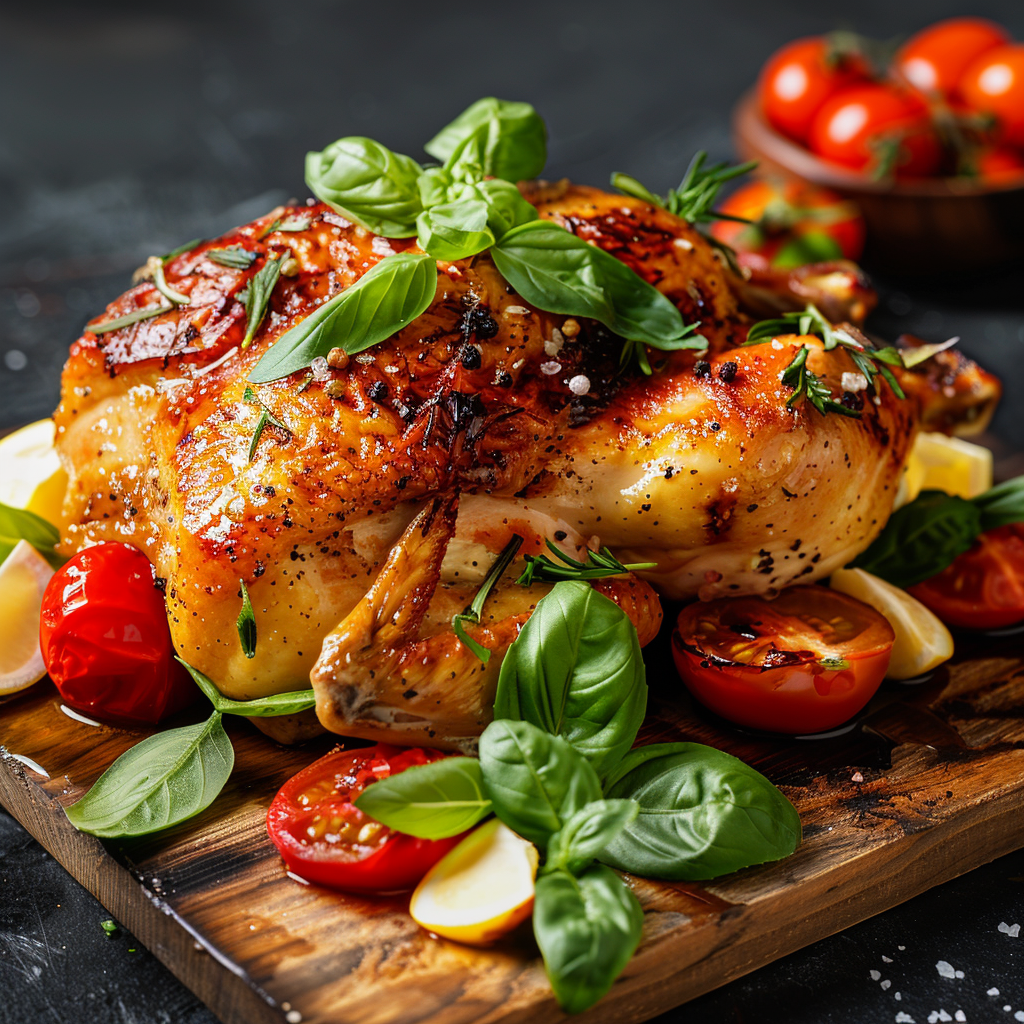Introduction To Internal temperature for chicken
Understanding the importance of cooking chicken to the right internal temperature is crucial for both taste and safety. Cooking chicken properly not only helps prevent foodborne illnesses but also ensures that the meat remains juicy and flavorful. By achieving the correct internal temperature, you can enjoy a perfectly cooked chicken every time. In this guide, we’ll cover everything you need to know about checking the internal temperature of chicken, including the tools you’ll need, the recommended temperatures for different cuts, and tips for ensuring your chicken is cooked to perfection.
What You’ll Need
Before diving into the cooking process, it’s essential to gather all the necessary tools and ingredients. Having everything on hand will make the cooking process smoother and more efficient.
Reliable Meat Thermometer
A reliable meat thermometer is your best friend when it comes to ensuring your chicken reaches the correct internal temperature. This tool helps you avoid undercooking or overcooking the meat, guaranteeing both safety and optimal taste.
Chicken (Whole, Breasts, Thighs, etc.)
Depending on your recipe and preferences, you might choose different cuts of chicken. Whether you prefer a whole chicken, breasts, thighs, or drumsticks, it’s important to select high-quality meat for the best results.
Cooking Utensils
- Oven: Perfect for roasting and baking chicken.
- Grill: Adds a smoky flavor to your chicken.
- Pan: Ideal for searing and stovetop cooking.
Ingredients
- Various Cuts of Chicken: Choose your favorite parts.
- Seasoning: Salt, pepper, herbs, and spices to enhance the flavor.
- Cooking Oil or Butter: For cooking and adding moisture.
Having these items ready will ensure you’re prepared to cook your chicken to perfection. In the next section, we’ll go over how to check the internal temperature of chicken to ensure it’s safe and delicious.
Instructions about Internal temperature for chicken

Cooking chicken to the right internal temperature is essential for both safety and flavor. Follow these instructions to ensure your chicken is perfectly cooked every time.
Checking Internal Temperature for chicken
Insert the Thermometer
To get an accurate reading, insert the meat thermometer into the thickest part of the chicken. Steer clear of touching the bone to avoid inaccurate temperature readings. For whole chickens, the thickest parts are typically the inner thigh, wing, and the thickest part of the breast.
Read the Temperature
Once the thermometer is properly inserted, wait for a few seconds to get a steady reading. Ensure the thermometer reaches the correct internal temperature for the specific cut of chicken you are cooking.
Recommended Internal Temperatures
Knowing the correct internal temperatures for different cuts of chicken is vital for safe cooking.
Whole Chicken
- The safe internal temperature for a whole chicken is 165°F (74°C).
- Measure the temperature in the inner thigh, wing, and thickest part of the breast to ensure the entire chicken is cooked.
Chicken Breasts
- Chicken breasts should reach an internal temperature of 165°F (74°C).
Chicken Thighs and Drumsticks
- These cuts are safe at 165°F (74°C) but are often more tender and flavorful at 175°F (79°C).
Ground Chicken
- Ground chicken should reach an internal temperature of 165°F (74°C) when cooked.
By following these instructions and using a meat thermometer, you can ensure your chicken is cooked safely and retains its juicy, delicious flavor. In the next section, we’ll explore the nutritional value of chicken and how to serve and store it properly.
Nutrition Score
Chicken is not only a versatile and delicious protein, but it also offers significant nutritional benefits. Understanding the nutritional value of chicken can help you make healthier choices and incorporate it effectively into your diet.
High in Protein
Chicken is an excellent source of high-quality protein, which is essential for building and repairing tissues, producing enzymes and hormones, and supporting overall body functions. A single serving of chicken can provide a substantial portion of your daily protein requirements.
Low in Fat
Especially in skinless cuts, chicken is relatively low in fat compared to other meats. This makes it a healthier option for those looking to reduce their fat intake without compromising on protein. The fat that is present in chicken is mostly unsaturated, which is better for heart health.
Provides Essential Vitamins and Minerals
Chicken is rich in essential vitamins and minerals, including:
- Vitamin B6: Vital for brain health and energy metabolism.
- Vitamin B12: Crucial for nerve function, DNA production, and red blood cell formation.
- Niacin: Aids in converting food into energy and supports digestive health.
- Phosphorus: Crucial for healthy bones and teeth.
- Selenium: A potent antioxidant that bolsters the immune system.
Health Benefits
Including chicken in your diet can contribute to better overall health. The high protein content supports muscle growth and maintenance, while the vitamins and minerals promote various bodily functions. Additionally, choosing lean cuts can aid in weight management and cardiovascular health.
Chicken’s nutritional profile makes it a great addition to a balanced diet. In the next section, we’ll cover how to serve and store chicken properly to maintain its quality and flavor.
Serving & Storage

Properly serving and storing chicken ensures that you maintain its flavor, texture, and safety. Here are some tips to help you get the most out of your cooked chicken.
Serving
Resting Time
Allow the chicken to rest for a few minutes post-cooking before serving. This allows the juices to redistribute throughout the meat, making it more tender and flavorful. A resting time of about 5-10 minutes is usually sufficient.
Pairing with Sides
Chicken pairs well with a variety of sides, enhancing its flavor and providing a balanced meal. Consider these options:
- Vegetables: Steamed, roasted, or grilled vegetables complement chicken nicely and add essential nutrients to your meal.
- Rice: Whether white, brown, or wild, rice is a versatile side that can absorb the delicious juices from the chicken.
- Salads: A fresh salad adds a crunchy texture and refreshing taste that balances the richness of the chicken.
Storage
Refrigeration
Store cooked chicken in an airtight container in the refrigerator. Properly stored, cooked chicken can last up to 4 days in the fridge. Ensure the container is sealed to prevent the chicken from drying out and absorbing other food odors.
Freezing
For longer storage, freeze cooked chicken in freezer-safe bags or containers. Mark the containers with the date to monitor storage duration. Frozen cooked chicken can be stored for up to 4 months. To reheat, thaw the chicken in the refrigerator overnight and then heat it thoroughly before serving.
Reheating Tips
When reheating chicken, ensure it reaches an internal temperature of 165°F (74°C) to maintain food safety. You can reheat chicken using various methods:
- Microwave: Quick and convenient, but be sure to cover the chicken to retain moisture.
- Oven: Reheat at a low temperature (about 325°F or 165°C) until warmed through.
- Stovetop: Use a skillet over medium heat, adding a little water or broth to prevent the chicken from drying out.
Proper serving and storage techniques will help you enjoy your chicken at its best, even as leftovers. In the next section, we’ll explore different variations of cooking chicken to add some variety to your meals.
Variations
Cooking chicken offers endless possibilities. Different cooking methods can bring out unique flavors and textures, making chicken a versatile ingredient in your culinary repertoire. Here are some popular variations:
Grilled Chicken
Grilling chicken imparts a smoky flavor that many find irresistible. To ensure grilled chicken reaches the safe internal temperature of 165°F (74°C), use a meat thermometer. Marinate the chicken before grilling to enhance its flavor and keep it moist. Popular marinade options include lemon herb, BBQ, and teriyaki.
Tips for Perfect Grilled Chicken
- Preheat the grill to medium-high heat.
- Oil the grill grates to prevent sticking.
- Cook chicken breasts for about 6-8 minutes per side, adjusting time for thickness.
- Use indirect heat for larger cuts like whole chicken or bone-in thighs.
Baked Chicken
Baking is a simple and effective method for cooking chicken. Baking at a consistent temperature ensures even cooking. Preheat your oven to 375°F (190°C) and bake until the internal temperature reaches 165°F (74°C). Baked chicken can be seasoned in countless ways, from simple salt and pepper to elaborate herb crusts.
Tips for Juicy Baked Chicken
- Use a baking dish that fits the chicken pieces snugly.
- Cover the chicken with foil during the initial cooking phase to lock in moisture.
- Remove the foil to allow the skin to crisp up during the final 10-15 minutes.
Slow Cooker Chicken
Slow cooking is perfect for those who prefer a hands-off approach. It’s also ideal for tougher cuts like thighs and drumsticks, which become incredibly tender when cooked slowly. Set your slow cooker to low for 6-8 hours or high for 3-4 hours. Make sure the chicken hits the recommended internal temperature before serving.
Tips for Flavorful Slow Cooker Chicken
- Brown the chicken pieces in a pan before adding them to the slow cooker to enhance the flavor.
- Add vegetables, broth, or sauce to create a complete one-pot meal.
- Resist the temptation to lift the lid frequently, as this releases heat and prolongs cooking time.
Other Popular Variations
- Fried Chicken: For a crispy treat, coat chicken pieces in seasoned flour and fry until golden brown and cooked through.
- Poached Chicken: Cook chicken gently in simmering water or broth for moist, tender results, ideal for salads and sandwiches.
- Stir-Fried Chicken: Quick and flavorful, stir-frying chicken with vegetables and a savory sauce makes for a delicious and healthy meal.
Experimenting with different cooking methods can keep your meals exciting and cater to various tastes and dietary preferences. In the next section, we’ll address some frequently asked questions about cooking chicken.
FAQs about Internal temperature for chicken
When it comes to cooking chicken, several common questions often arise. Here are some frequently asked questions along with their answers to help you cook chicken safely and deliciously.
What is the Safe Internal Temperature for Chicken?
The safe internal temperature for chicken is 165°F (74°C). This temperature ensures that any harmful bacteria present in the chicken are destroyed, making it safe to eat. Use a meat thermometer to check the internal temperature at the thickest part of the chicken.
How Do I Check the Internal Temperature of Chicken?
To check the internal temperature of chicken, insert a meat thermometer into the thickest part of the chicken without touching the bone. Wait for a few seconds to get a steady reading. Make sure the thermometer reads at least 165°F (74°C) before removing the chicken from the heat.
Can Chicken Be Eaten at 160°F?
It’s recommended to cook chicken to 165°F (74°C) to ensure safety from harmful bacteria. Although some recipes may suggest that 160°F is safe, the USDA advises 165°F as the safe minimum internal temperature to guarantee that all parts of the chicken are safe to eat.
Why Is My Chicken Dry After Cooking?
Chicken can become dry if it is overcooked. To avoid this, remove the chicken from the heat as soon as it reaches the safe internal temperature of 165°F (74°C). Allow the chicken to rest for a few minutes after cooking to retain its juices. Using a marinade or brine before cooking can also keep the chicken moist.
What Are the Best Methods to Reheat Chicken?
Reheating chicken properly ensures it remains safe and tasty. Here are some methods:
- When microwaving, cover the chicken to keep it moist and heat in short bursts.
- Oven: Reheat at a low temperature (about 325°F or 165°C) until warmed through.
- Stovetop: Use a skillet over medium heat with a little water or broth to prevent drying out.
Make sure the reheated chicken reaches an internal temperature of 165°F (74°C) before eating.
How Long Can Cooked Chicken Be Stored?
- Refrigeration: Cooked chicken can be stored in an airtight container in the refrigerator for up to 4 days.
- Freezing: For longer storage, freeze cooked chicken in freezer-safe bags or containers for up to 4 months. Mark the containers with the date to monitor storage time.
How Can I Tell if Chicken is Spoiled?
Spoiled chicken often has a foul odor, slimy texture, and a change in color to grayish or greenish. If you notice any of these signs, it’s best to discard the chicken to avoid foodborne illnesses.
Conclusion about Internal temperature for chicken
Achieving the perfect internal temperature for chicken ensures it is both safe to eat and delicious. Cooking chicken properly is crucial for preventing foodborne illnesses and retaining the meat’s juicy, flavorful qualities. By using a reliable meat thermometer, you can accurately measure the internal temperature and avoid overcooking or undercooking your chicken.
We’ve covered the essential tools and ingredients needed for cooking chicken, as well as the correct internal temperatures for various cuts. From grilled to baked to slow-cooked variations, there are numerous ways to prepare chicken that cater to different tastes and preferences. Additionally, understanding the nutritional benefits of chicken can help you incorporate this versatile protein into a balanced diet.
Proper serving and storage techniques ensure that your chicken remains tasty and safe to eat, whether enjoyed immediately or saved as leftovers. By following the guidelines and tips provided, you can confidently cook chicken that is both safe and flavorful.
Remember, always check the internal temperature, let the chicken rest before serving, and store leftovers properly to maintain quality and safety. Experiment with different cooking methods and seasonings to keep your meals exciting and delicious.

2 thoughts on “The Internal Temperature for Chicken”